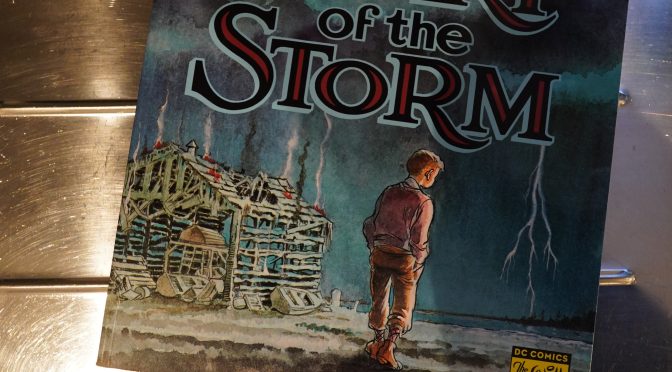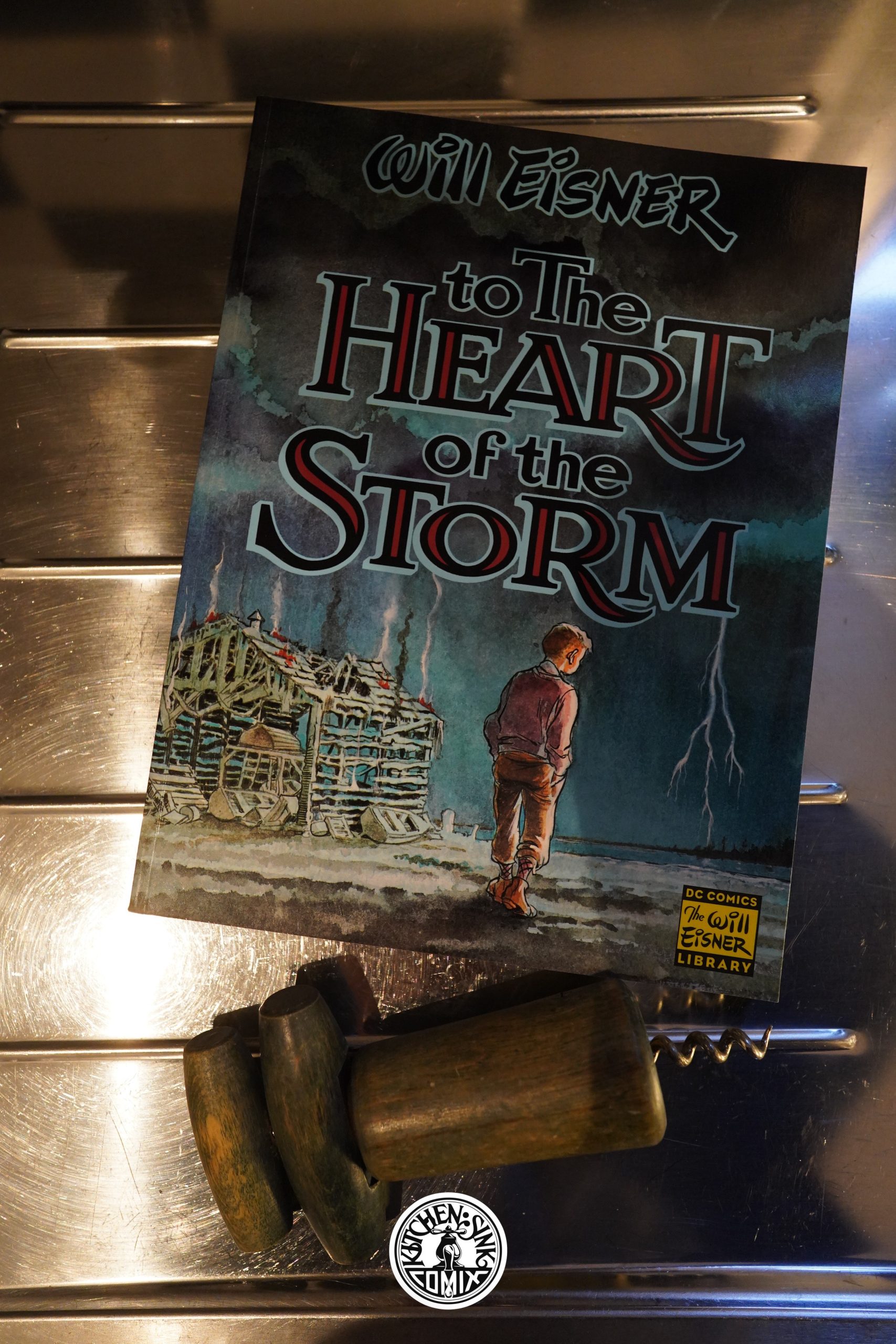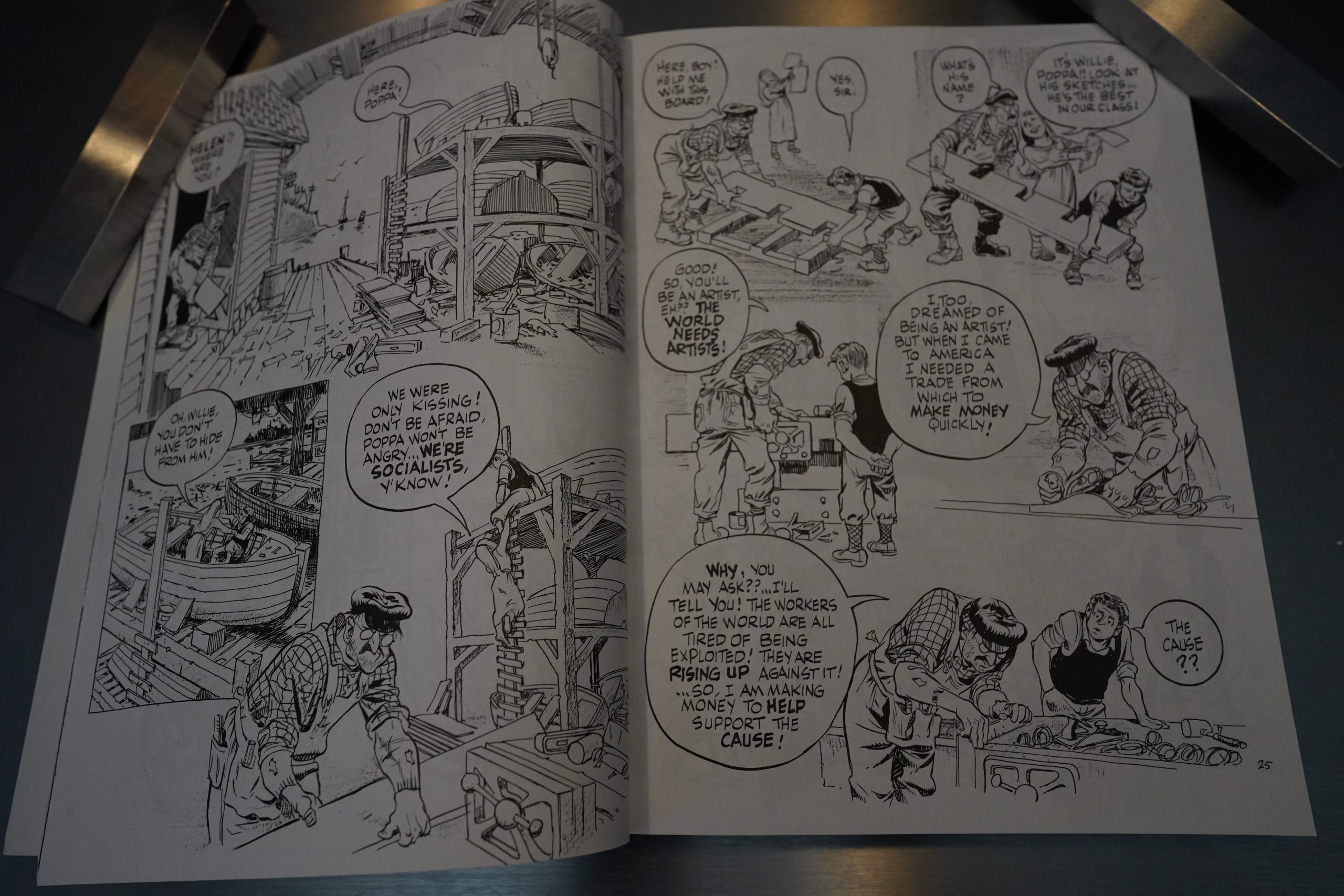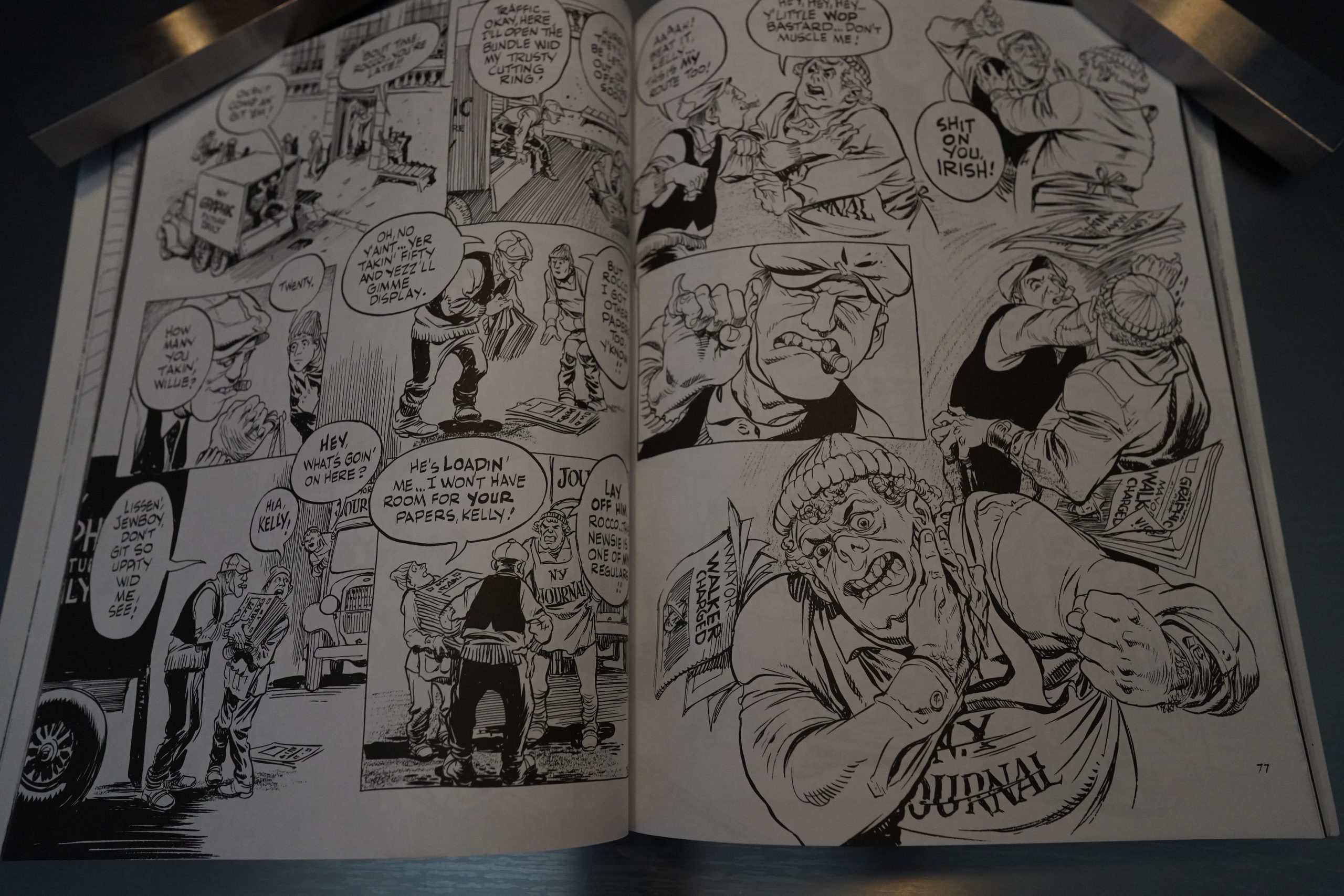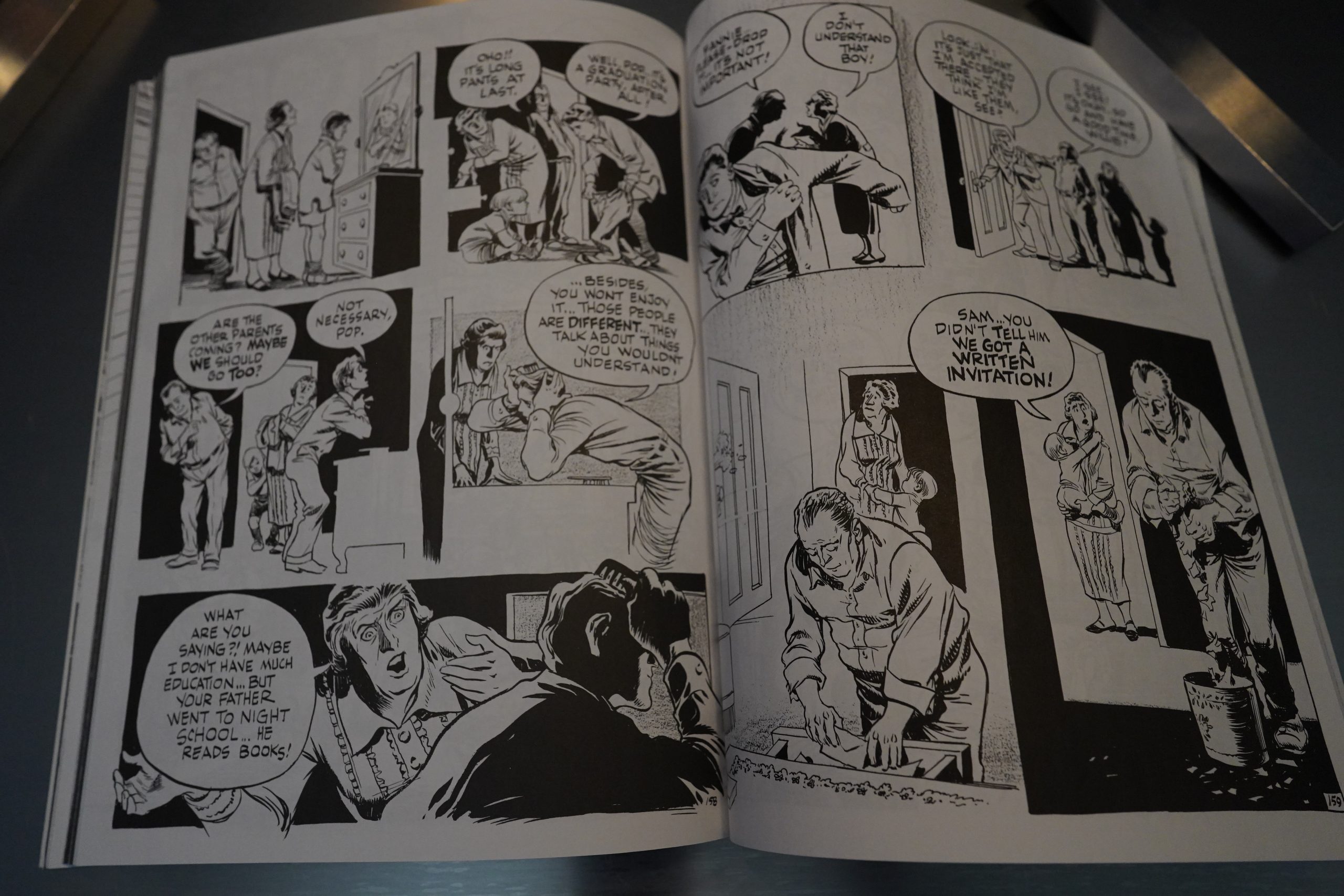To the Heart of the Storm (1991) by Will Eisner
Oops! I’ve got the DC edition of this book here instead of the earlier Kitchen Sink version…
This feels, in some ways, like Eisner’s magnum opus — it covers the same ground as he’s done before, but more thoroughly. And this time over, it’s presented as one single tale, instead of a series of vignettes.
The structure is classic — Eisner has been drafted in 1942, and on the train down to camp, he’s thinking about olden times. (Well, I’m assuming “Willie” is Will Eisner — the book doesn’t say whether it’s fiction or autobiography.)
And we get… a bunch of vignettes from Eisner’s life — quite a lot from his childhood, and some from his teenage years. But these aren’t random vignettes: They’re (almost all) on the theme of living as a Jewish boy in New York, and the prejudices and abuse he suffered.
Finally somebody sensible!
So it seemed like we were going to have something more focused than Eisner’s usual books, but nope: We then get a whole bunch of flashbacks inside the flashbacks to Eisner’s parents, and their parents even. And it’s not that the individual anecdotes aren’t interesting — but there’s just a lot of them. So it’s a book without any momentum, and is instead a contemplative, kinda quiet book.
Except for the melodrama. Oh, so much melodrama. It gets a bit hard to take after a while — the family suffers so many setbacks that it gets a bit difficult to take seriously after a while.
There’s interesting stuff all along, though, like the on-ground newspaper distribution wars here.
Eisner shifts between doing free-flowing layouts without (clear) panels, to doing more traditional layouts, apparently on a whim. But it reads well — it’s got a nice flow.
Eisner is pretty reticent about including really embarrassing stuff here (as autobiographies go), but the bit about passing as a gentile to go to a German girls’ prom thing (and disinviting his own parents) is shockingly heartbreaking.
So… I think this might be one of Eisner’s most successful works — it’s structurally sound, and has real flow, and doesn’t any of the many 40s schlock twists and turns that mar much of his other work. But it’s not exactly a thrilling book: It feels somewhat self-indulgent. Not all of the anecdotes we get are all that interesting.
Rob Rodi writes in The Comics Journal #144, page 45:
Will Eisner honed his craft, and
what many would call his art (l “Ouldn’t dis-
agree) on the seven-page Spirit sections he
created for Sunday newspapers during the 1940s
and 1950s. He became an expert at conveying
much more than was actually on the page; his
works were little miracles Of succinctness.
Thirty-odd years later, that’s still where his
greatness lies; the shorter the works, the bet-
ter. His first collection of non-genre stories, A
Contract with God, is very fine, and City Peo-
ple’s Notebook and New York: The Big City, two
recent volumes of even briefer pieces (often
nothing more than observations) are his most
graceful and powerful works to date; some
of the vignettes achieve an almost mythic
transcendence.
So it’s not surprising that To the Heart ofthe
Storm, his years-in-the-making, 208-page,
quasi-autobiographical graphic “novel,” should
prove to be such a disappointment; it plays to
his weaknesses. Its rambling. episodic structure
leads the reader in too many different directions,
and while certain sequences are memorable,
they don’t cohere into a thematic whole. Liber-
ated from page-count restrictions, the master Of
economic storytelling has no idea what to do.
The confusion starts almost immediately.
The title of the work suggests an inexorable des-
cent into sound and fury — and the kind of
sound and fury we’re expecting is war (World
War II, to be exact). After all, on the first page,
we’re given a look (in a rather uninspired
documentary fashion) at the induction of raw
recruits into the armed services in 1942. “It was
a time of thunder and lightning” is the opening
line, and though your eyes may fog a little at
so cliched a metaphor, at least you’re pretty sure
where you’re being led. And sure enough, the
next pages find us on a train heading south with
a couple of newly enlisted men. We don’t know
much about them, until someone in an adjoin-
ing seat turns and asks one of them, “Whad-
daya know, buddy?” and gets the reply, “All I
know is…This is World War II…We’ve been
drafted.. .We’re on a troop train going to some
training camp…He’s a cartoonist and I’m an
editor of a Turkish newspaper in Brooklyn.” (All
of which kind of reminds me of the get-it-out-
of-the-way-in-one-breath backstory you’d hear
characters spout at the beginning of ’40s “B”
pictures, except I don’t think even they were
quite so blatant about it.)
But then, instead of following these draftees
to their destinations and then on to Europe and
war, we’re almost immediately sidetracked by
an extended flashback sequence, as played out
in the window of the train that a draftee named
Willie (the Eisner character) is staring into. The
flashback takes place in 1928, and recounts Wil-
ly’s family’s move from Brooklyn to the Bronx,
where, Willie’s mother warns, Jews musn’t feel
too safe, as there are “Italians, Irishers, and
Only knows what else on the block.” Despite the
warning, Willie promptly gets into a fight with
some local toughs, after which his father
demonstrates that a Jew needn’t fight — he can
always think and talk his way out of a potential-
ly dangerous situation. The sequence is cute;
but what, you uonder, is it doing here? You ask,
when do we get back to the war?
The answer is, we don’t; every flashback
leads to another flashback — there are even
flashbacks-within-flashbacks — which collec-
tively comprise a nonlinear history Of Willy’s
family. The focus, in most of these (but not all),
is on the way anti-Semitism permeated our
culture in the early decades of the century, and
of the ways immigrant and first-generation
American Jews dealt (or avoided dealing) with
such oppression.
Eisner is often very affecting on this theme,
especially in the story Of Willie’s summer-long
toil at building a sailboat with his best friend,
Buck (a Gentile of German ancestry). While the
noisy politics Of race obsess the boys’
tive families, the boys themselves become in-
creasingly and pleasurably immersed in their
project, oblivious (or nearly so) to all the
ruckus. The pacing the tone of this sequence
are exactly right; it’s one of the best represen-
tations of a pure boyhood friendship (the kind
men can’t have, because they’ve learned about
status and money and power) that I’ve seen in
this medium. Eisner conveys Willie and Buck’s
golden afternoon with perfect control and a
sureness of touch.
But virtually all the other sequences are
simply overwrought —
particularly the
flashback-within-a-flashback in which Willie’s
mother tells him the story of her life. (“Let me
tell you,” she moans, “I know from experi-
ence… life is not exactly perfect.. .you have to
do with what you given. . .for me it was
never easy.. .never.. ..”And that’s just the se-
gue.) I’ll give Eisner the benefit of the doubt
and presume that the litany of oppressions that
constitute Willie’s mother’s life conforms to the
hard facts Of Eisner’s (Nn mother’s life; but the
tenor of that life has here been hyped up to an
almost hysterical degree — it comes off as a kind
of melodramatic binge. As her troubles magniW,
Fannie Wolf clutches her breast, she to her
knees, she raises her hands in supplication to
those who might help her. She’s a vulnerable
innocent in a hard, cruel world, ami we’re PNC-
tically exhorted to weep for her. But the fever
pitch of the narrative subverts any sympathy we
might have for her; I found myself remember-
ing Oscar Wilde’s remark on Dickens’s The Old
Curiosity Shop: “One would need a heart Of
stone not to laugh at the death of Little Nell.”
The problem here is that the exaggerated,
cynical cartoon vocabulary that Eisner invented
so many years ago works for his ironic,
comic Spirit stories (and for his short urban
anecdotes), but it’s not remotely suited for
anything resembling an epic Or a saga. Every
artist has limitations, and maybe Eisner simply
hasn’t come up against his before; but just as
Damon Runyon couldn’t have written Anna
Karenina, Eisner can’t pull off the kind of thing
he’s trying for here — it’s beyond his range.[…]
So, To the Heart of rhe Storm doesn’t take
us into the heart of a storm at all — the best
it can manage is a couple of quick cloudbursts.
Had Eisner presented this as a stream-of-
consciousness memoir, or a kind of folk family
history, it might have gone down more easily;
but its pretensions sink it. What is the purpose
of the framing sequence (Willie on the troop
train heading toward boot camp)? Why is the
title of the work To the Heart of the Storm? Is
Eisner really suggesting that American anti-
Semitism Or ethnic separatism was a cause of
the Second World War? Your guess is as good
as mine. (If he thinks it is, he needs to give us
more proof.)
Eisner himself explains how this confusion
came about in his introduction: “I intended to
deliver a narrowly fictional experience of that
(pre-war) climate, but in the end, it metamor-
phosed into a thinly-disguised autobiography.”
Why, then, keep us pointed at the “Storm” in
Europe if the only storm he’s going to show us
is the teapot variety?[…]
I don’t mean to dismiss Eisner as an old
master who can’t learn new tricks (a label that
seems, sadly, to apply to Harvey Kurtzman); his
range may be limited, but there is plenty to ex-
plore within that range — besides which, the
autobiographical form has sabotaged other
writers and artists (Ray Bradbury and Federico
Fellini come to mind). It tempts them with the
sort of excesses of sentimentality they otherwise
would have enough objective distance to avoid.
I can’t believe, for instance, that Eisner would
have made Fannie into such an impossibly vir-
tuous cipher if the character hadn’t been based
on his mother. We’re only shown her suffering
and endurance; we never feel any identification
for her — we never even know whether she loves
(or has ever loved) her husband
Well… I think that’s a fair review, but I disagree with some of it.
Bruce Canwell writes in Amazing Heroes #191, page 112:
Only Eisner’s youthful counterpart
Willie is able to avoid the mistakes of
his father: in World War I Sam Eisner
immigrated from Austria to America
to avoid conscription, then he married
shortly after attaining citizenship to
avoid the U.S. military draft. But
when Willie is called upon to serve
during World War II he refuses all the
available dodges and reports for
duty—he is determined to face the
unknown rather than perpetuate old
ways, old mistakes; Only when a
person can make such a decision is he
truly an adult; only then can he break
the vicious cycle of bigotry.
The story is richly textured, the art
is fluid and full offemotion—united,
they turn To the Heart of the Storm
into a major comics experience, a fit-
ting companion to Eisner’s A Contract
with God, A Life Force, and that most
underappreciated graphic novel, The
Dreamer.
If there is any justice in the world,
Mr. Kitchen and Mr. Eisner are gonna
sell a lot of copies of this one… •
The Comics Journal #146, page 11:
You Eisner-
Basher, You
RANDY REYNALDOOf all the “Eisner-bashing” I’ve seen
in the Comics Journal in the last couple of years,
I was compelled to comment on Rob Rodi’s
negative review of Will Eisner’s graphic novel,
To The Heart of the storm (Journal #144).
I disagree with Rodi’s assertion that the book
doesn’t cohere to a “thematic whole.” Many of
the flashback sequences recounted in the graphic
novel not only underscore Eisner’s theme of
anti-Semitism (as well as racism and prejudice
on a larger scale) , but also demonstrate how they
shaped him as an artist and an adult. Rodi in
his own review points out th… many of the
story’s episodes revolve around “the way that
anti-Semitism permeated our culture in the early
decades of the century.” Furthermore, many of
these scenes are Often echoed throughout the
work, strengthening the cohesion of the story
even more.
Eisner uses America’s entry into World War
II, for instance, to create a parallel between the
son, Willie (Eisner), entering the service and
the father, Sam, •who left Austria at the begin-
ning of WOrld War I to avoid the draft. Although
he too could have avoided the draft, young Willie
decides to enlist because, unlike the father, Wil-
lie is more enfranchised as an American Jew
than his father was as an Austrian Jew. Because
they were only one of Many ethnic groups strug-
gling to establish themselves, Eisner shows that
Jews had more opportunities to integrate into
the mainstream and succeed in the U.S. than in
Austria. Willie’s father welcomed and encour-
aged this integration, sometimes over his wife’s
objections, by choosing to live in non-Jewish
areas and not discouraging Willie to make
friends with non-Jews. As a result, Willie is will-
ing to fight when the U.S. enters the war.
Eisner is not suggesting, however, that this
period was not without its problems; nor, as
Rodi proposes, is Eisner suggesting that “Amer-
ican anti-separatism or ethnic separatism was
a cause of the Second World War.” Instead,
superimposing world War II over Willie’s mem-
ories allows Eisner to demonstrate the irony of
Americans happily going off the war to fight
ethnic-based oppression without realizing that
similar prejudices existed right here at home.
As Rodi points out, young Willie is told that “a
Jew needn’t fight,” but as he matures, Willie
finds out that sometimes there’s no choice,
especially if it’s for a cause one believes in —
even the pacifistic and often compromising
father understood that.
In direct response to one of the questions
raised in Rodi’s review, the purpose of the fram-
ing sequence (the train trip to boot camp) is to
create a metaphoric link to the father’s asser-
tion that “life is a journey” — this too creates
a coherence that ties many of the stories within
the book together. This “journey,” along with
the parents’ own experiences and attitudes, all
contribute to the sum of Willie, the adult.
(A parent’s attitudes can have a negative ef-
fect on an individual as well; when Willie’s
mother tries to convince him that his father is
a failure as a businessman, Willie comes to his
defense by asking his father for business advice,
thus embarrassing his mother. This reverence
Of the father over the mother, which partly
results from the father and son’s similar tem-
peraments, may explain why the mother
sometimes comes across as unsympathetic.)[…]
ROB RODI REPLIES: Randy, I’d like to reply to
your letter at greater length than I’m able to;
unfortunately, once I’d finished with it, I threw
Out the photocopy of To the Heart of the Storm
that was sent to me for review. This was not an
aesthetic decision, but a practical one. The need
for art may be strong, but the need for closet
space is eternal.
Even so, the work is fresh enough in my
mind to allow a few general responses.
First off: you state that “superimposing
World War II over Willie’s memories allows
Eisner to demonstrate the irony of Americans
happily going off to war to fight ethnic-based
[sic] oppression without realizing that similar
prejudices existed right here at home.” But it
isn’t the nur that frames (not superimposes) the
flashback sequences; it’s Willie’s ride on a troop
train. And his fellow recruits aren’t “happily go-
ing off to war” — they seem a bit dazed, if
anything; Willie’s seatmate even gives voice to
the general bewilderment. And, most impor-
tantly, WOrld War II was far more than a fight
against ethnic oppression; Germany’s invasion
and occupation of Austria, France, et al, was
a far greater incentive to fight than the plight
of Jews, Slavs and gypsies under Nazi rule. So
if it was German oppression of ethnic groups
that inspired Willie and his fellow soldiers to
enlist, Eisner should’ve said so.
But, uait — just as To the Heart ofthe Stom
doesn’t cohere, neither, it seems, does your let-
ter. A paragraph later you write that “the pur-
pose of the framing sequence [the train trip to
boot camp] is to create a metaphoric link to the
father’s assertion that ‘life is a journey'”; but
this contradicts what you just said about the pur-
pose of the framing sequences being to demon-
strate the “irony” of ethnic Americans going
abroad to fight ethnic oppression when it exists
in such force at home. Now, I know that in a
sophisticated work of fiction, a narrative device
(such as the train trip) can do thematic double-
duty — but To the Heart of the Storm is far from
a sophisticated work of fiction. Its characters
are leaden, its tone is consistently overwrought,
and its various themes — even presuming you’re
correct in your assertions — are deadeningly
banal: “life is a journey,” “it’s ironic to fight
oppression abroad when it exists at home.”[…]
In the end, I can’t help thinking that you put
more work into analyzing Eisner’s intentions
than Eisner did, which is, I think, a common
failing of critics who approach cartoonists of
Eisner’s stature. His reputation not only sends
many nascent critical sensibilities scampering
away into dark corners, it also inspires even
those who should know better to give him the
benefit of the doubt when they see something
in his work that quite register. “He’s WIII
Eisner; he must have meant to do that,” they’ll
tell themselves. “And if I think hard enough,
I’ll find a reason he could’ve meant it.”
Fortunately, most of the Journal writers are
made of sterner stuff; I think few of us would
deny Eisner’s contributions to the comics me-
dium, but the “Eisner-bashing” you refer to in
these pages is, even so, not a case of lese-
majesre. Eisner is a working cartoonist, and
must continue to be judged as such. If you want
to hear the usual chorus of hosannahs every time
Eisner puts his pen to paper, there are plenty
of publications devoted to slavishness of that
sort; but as a Journal critic, I say a cartoonist
is only as good as his most recent work. It’s up
to those of us who want to see the medium grow
to stand toe to toe with such artists and say,
“What have you done for us lately?”
Harsh!
This book has been reprinted several times. Here’s some reviews on the interwebs:
Ironically, a lot of Eisner’s autobiographical stuff is really boring. He gets into fights with the neighbourhood kids because he’s Jewish, he builds a small boat with a wealthy German kid – ehhh. It’s nothing special.
To the Heart of the Storm isn’t among my favourites of Will Eisner’s books, and I wouldn’t say it’d appeal to anyone but fans, but it’s not a bad read, particularly if you’re in the mood for a Dickensian comic!
Hm:
The one criticism that could possibly be levelled is the simplicity of characters’ approach to situations, which could come across as being stereotyped and formulaic, but equally, could just be the obverse of the energy and straightforward narrative drive of the story. It would rather be like criticising Hamlet for being full of cliches and hackneyed old sayings. It’s a ‘Yes’. Highly recommended.
Hm:
From his denial of Jewish prejudice in America to his determination to escape a cultural stereotype by choosing to fight in World War II, Eisner’s story feels familiar and overlooked. This book comes highly recommended for its high quality narrative and illustrations, as well as the reminder it serves about America’s own history and legacy of continued discrimination during a time period when history books still too often overemphasize the country’s blameless and heroic character.
There sure are a lot of reviews:
We found the way in which the author’s train-travelling alter ego remembers his past to be a little too chaotic though, especially interspersed as it is with further dramatised recollections built from the memories of his parents. This is probably one best left to those with a particular interest in the era or the circumstances in which Eisner grew up, as it left us feeling like we wanted more, that too few conclusions had been drawn. Or perhaps that’s just the way life is.
So… it doesn’t seem to be a generally well-reviewed book — opinions differ more than usual for Eisner.
This is the one hundred and thirty-first post in the Entire Kitchen Sink blog series.
